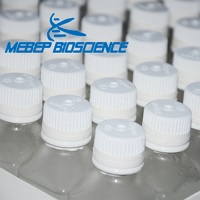
Trypsin
2021-08-14
Rox Reference Dye
2021-08-16Description
RTGreen is a very sensitive dye for the detection of double stranded DNA (dsDNA). The dye is a green fluorescent nucleic acid dye with features that make it useful for non-specific detection of amplification in realtime qPCR experiments.
Compared with the widely used SYBR Green I, RTGreen dye is generally less inhibitory toward PCR and less likely to cause nonspecific amplification , RTGreen dye can be used at a much higher dye concentration than SYBR Green I, resulting in more robust PCR signal.
The PCR reaction can be monitored using our existing optical setting for SYBR Green I or FAM on any commercial real-time PCR cycler. The qPCR protocol provided below is for PCR using regular non-hot-start Taq. Use of a hot-start Taq may require some adjustment of PCR buffer composition in terms of ionic strength and pH to best take the advantage of RTGreen dye. The water soluble solvent such as DMSO or glycerol are frequently added to stabilize master mixes. These components and pH may need to be optimized depending on the enzyme used.
Notes
- Always use positive and negative controls when doing qPCR experiments.
- The temperature program for the qPCR amplification does not differ from standard PCR program for the given template and primers.
- For the detection, FAM or FAM/SYBR channel should be used.
- When using ABI Sequence Detection Systems, make sure to select NONE for the passive reference under the tab WELL INSPECTOR.
- BSA may be required if the reaction is run on a Roche LightCycler. A final BSA concentration of 0.5 mg/mL may be sufficient. With SYBR Green, addition of a protein such as BSA results in a fluorescence increase, which provides a background signal that triggers the start of a LightCycler. Because RTGreen dye is less sensitive to proteins, you may need to adjust the instrument setting (for background fluorescence) so that the instrument will start.
- For iCycler users, you do not need to add FAM to your PCR mix because RTGreen has a slight background fluorescence that provides an adequate and stable baseline level fluorescence for well calibration.
- For chemically-modified Taq, it may be necessary to reduce the KCl concentration and increase the Tris concentration.
- The optimal Mg2+ concentration for PCR with RTGreen dye is 2.5 mM.
- Before pipetting, warm up the 20X solution to room temperature and thoroughly mix the solution by vortexing. RTGreen is highly stable. However, dye may adsorption to the vial during storage. Vortex the vial for a few seconds to make sure the dye is fully dissolved.
- For best results, a hot-start enzyme should be used. However, buffer formulation may need to be adjusted.


